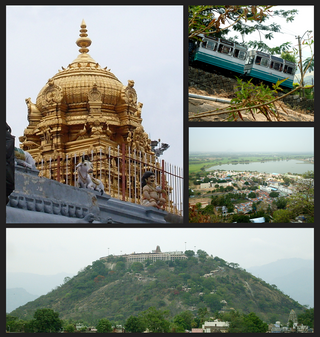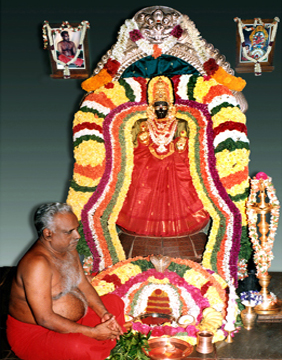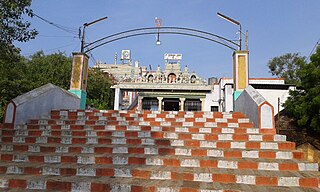
Thaipusam or Thaipoosam is a Tamil Hindu festival celebrated on the full moon of the Tamil month of Thai (January/February), usually coinciding with Pushya star, known as Pusam in Tamil.

Palani (Tamil:[paɻani] or Palnias in British records, is a town and a taluk headquarters in Dindigul district of the western part of Tamil Nadu state in India. It is located about 106 kilometres south-east of Coimbatore and 122 kilometres north-west of Madurai, 67 kilometres from Kodaikanal. The Palani Murugan Temple or Arulmigu Dhandayuthapani Swamy Temple, dedicated to Murugan is situated on a hill overlooking the town. The temple is visited by more than 7 million pilgrims each year. As of 2011, the town had a population of 292301 which makes it the second largest town in the district after Dindigul.

Temple cars or Temple chariots are used to carry representations of Hindu gods around the streets of the temple on festival days. These chariots are generally manually pulled by the devotees of the deity.
The Saptha Kannimar Padal is one of the sub-sections of Arul Nool which was the secondary scripture of Ayyavazhi. This follows the concept of Saptha Kanya.The author of the content is unknown. This contains the event's background and reason for the birth of the seven virgins in the world. Below are the names of Saptha Kannimar:
- Brameshwari
- Kaumari
- Varahi
- Vaishnavi
- Chamundi
- Maheshwari
- Indrani

The Vayalur Murugan Temple is a Hindu temple dedicated to Muruga, son of Lord Shiva and Parvati, located in the village of Kumaravayalur in Tiruchirapalli district, Tamil Nadu, India. The temple is believed to have been initiated during the period of Medieval Cholas during the 9th century. The temple is maintained and administered by the Hindu Religious and Charitable Endowments Department of the Government of Tamil Nadu. Though the presiding deity is Shiva, the temple is known for the Murugan shrine. The temple is associated with Hindu savant, Kirupanandha Variyar.
Dhakshinamoorthy Pillai (1875–1936), was a leading mridangam and kanjira artist who accompanied musicians in Carnatic music concerts from 1875 to 1925.

Arulmigu Dhandayuthapani Swamy Temple is third of the Six Abodes of Murugan. It is located in the city of Palani earlier it was known as Thiruaavinankudi(as mentioned in the old Sangam literature Thirumurugatrupadai), Dindigul district, 100 kilometres (62 mi) southeast of Coimbatore and northwest of Madurai in the foothills of the Palani Hills, Tamil Nadu, India. Palani temple is considered synonymous with Panchamritam, a sweet mixture made of five ingredients.

The Kālikāmbal Temple is a Hindu temple dedicated to Shri Kāligāmbāl (Kāmākshi) and Lord Kamadeswarar, located in Parry's corner locality of the city of Chennai, Tamil Nadu, India. The temple is located in Thambu Chetty Street, a prominent financial street at Georgetown, running parallel to Rajaji Salai.

Suryanar Kovil is a Hindu temple dedicated to the deity Hindu Sun-God, Surya, located in Suryanar Kovil, a village near the South Indian town of Kumbakonam Thanjavur District in Tamil Nadu, India. The presiding deity is Suriyanar, the Sun and his consorts Ushadevi and Pratyusha Devi. The temple also has separate shrines for the other eight planetary deities. The temple is considered one of the nine Navagraha temples in Tamil Nadu. The temple is one of the few historic temples dedicated to Sun god and is also the only temple in Tamil Nadu which has shrines for all the planetary deities.
Kuzhanthai Velappar Temple is a Hindu temple in the Village of Poombarai near Kodaikanal in Dindigul.
Murugan or Balathandayuthapaniswamy temple is a Hindu temple situated in the village of Kumaranmalai at a distance of 10 kilometres from Pudukkottai in the Pudukottai district in Tamil Nadu, India. The temple is dedicated to the Hindu god Murugan and is situated on a small hillock. The temple encompasses a sacred tank whose water is considered holy.

Arulmigu Adhiparasakthi Siddhar Peetam is a Hindu temple in Melmaruvathur, approximately 92 km from Chennai in the southern state of Tamil Nadu, India. Tamil Nadu is the place where 21 Siddhars (saints) men as well as women from different religion, had their Jeeva-Samadhis. The divine mother Adhi Parashakti transmigrates into Arulthiru Bangaru Adigalar in Adiparashakti Siddhar Peetam.

The Chandiranaar Temple is a Hindu temple in the village of Thingalur, 33 kilometres (21 mi) from Kumbakonam on the Kumbakonam - Thiruvaiyaru road in the South Indian state of Tamil Nadu. The presiding deity is Soma (moon). However, the main idol in the temple is that of Kailasanathar or Shiva. The temple is considered one of the nine Navagraha temples in Tamil Nadu. Thingalur is the birth place of Appothi Adigal, one of the 63 nayanmars of lord Shiva and an ardent devotee of saint Thirunavukkarasar, though the temple has no assets related to the saint.

The Neelamegha Perumal Temple or Sowriraja Perumal Temple is a Hindu temple in Thirukannapuram, a village in the outskirts of Nagapattinam in the South Indian state of Tamil Nadu, is dedicated to the Hindu god Vishnu. Constructed in the Dravidian style of architecture, the temple is glorified in the Divya Prabandha, the early medieval Tamil canon of the Alvar saints from the 6th–9th centuries CE. It is one of the 108 Divya Desam dedicated to Vishnu, who is worshipped as Neelamegha Perumal and his consort Lakshmi as Thirukannapura Nayagi. As per Hindu legend, the presiding deity is believed to have appeared with a wig to save a devotee, leading to the name Sowriraja Perumal.

Anna Nagar Ayyappan Koil is a Hindu Ayyappan Temple dedicated to the deity Ayyappan in Chennai, India. It is located at the junction of 6th Main Road and 2nd Avenue in Anna Nagar.

Pachaimalai Arulmigu Subramanya Swamy Temple, also known as the Pachaimalai Balamurugan Temple, is one of the two major hill temples located in Gobichettipalayam, Tamil Nadu, India. The temple is dedicated to the Lord Murugan. The temple is constructed in the Tamil style of architecture and is located on top of a small hillock in the outskirts of the town of Gobichettipalayam near Pudupalayam, Tamil Nadu. Here, Kartikeya is venerated as Balamurugan or Subramanya Swamy.

The Hindu Religious and Charitable Endowments Department of the Government of Tamil Nadu manages and controls the temple administration within the state. The Tamil Nadu Hindu Religious and Charitable Endowments Act XXII of 1959 controls 36,425 temples, 56 mutts or religious orders, 1,721 specific endowments and 189 trusts.

Karunellinathar temple is a Hindu temple dedicated to Shiva, located in Thiruthangal, a town in the outskirts of Sivakasi, a in Tamil Nadu, India. Shiva is worshiped as Karunellinathar, and is represented by the lingam and his consort Parvati is depicted as Chokki Amman.

Thiruporur Kandaswamy temple in Thiruporur, a panchayat town in Chengalpattu district in the South Indian state of Tamil Nadu, is dedicated to the Hindu god Murugan. Constructed in the Dravidian style of architecture, the temple is believed to have been expanded during the 18th century with the images excavated from Thiruporur.
Kuzhanthai Velappar Temple is a Hindu temple in the village of Poombarai near Kodaikanal in Dindigul.

















